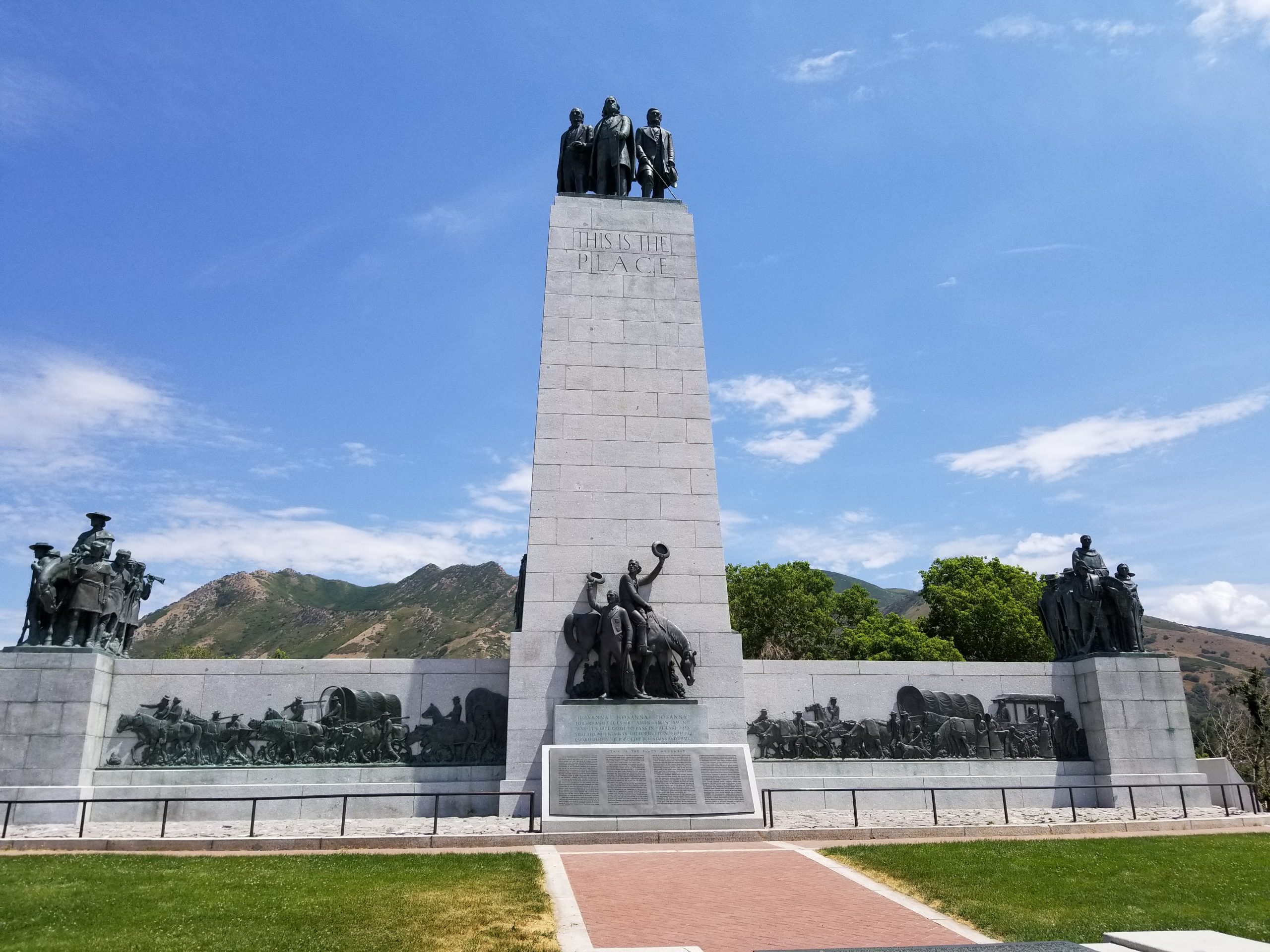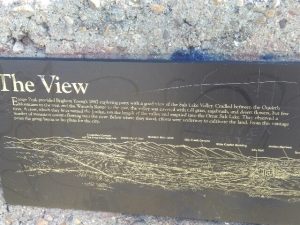Write-up by Jake Bardsley
Placed by: Pioneer Trails and Assoc.
GPS Coordinates: 40.7944° N, 111.8905° W
Plaque A: (on S. side of monument, replica of original PTLA 43) ENSIGN PEAK July 26, 1847, two days after the Mormon Pioneers entered this valley Brigham Young and party climbed to this point and with the aid of field glasses made a careful survey of the mountains, canyons and streams. In the group were Heber C. Kimball, Wilford Woodruff, George A. Smith, Ezra T. Benson, Willard Richards, Albert Carrington and William Clayton. Wilford Woodruff, first to ascend the Peak, suggested it as a fitting place to “set up an ensign” (Isaiah 11:12). It was then named Ensign Peak, subsequently the stars and stripes were raised here.
Plaque B: Free-standing concrete slab, NE of monument 1.5’W 2.5’H 8″D (drawing of flag raising) THE SUMMIT Before he left Nauvoo, Brigham Young said that Joseph Smith, the deceased prophet, had appeared to him in a vision and shown him a place where the banner of liberty should wave. When he viewed this peak as he entered the Salt Lake Valley on July 24, 1847, Brigham reportedly said, “This is the place,” adding “I want to go there.” Two days later, still weak from fever, he insisted on climbing the summit. Eight others made the hike with him where they spent several hours in prayer and counsel. They gazed over the valley and made plans for a new city. They wanted their new home to become the “ensign for the nations” of which Isaiah had prophesied in the Bible, hence the name Ensign Peak. No ensign, or flag, was flown on that occasion, but perhaps a yellow bandanna, tied to a cane, was raised as a symbolic gesture. Within a few weeks, an American flag was hoisted on the summit. Elevation 5,416 feet the elevation of Ensign Peak is 5,416 feet. This is 1,085 feet above the southeast corner of the temple block where the Salt Lake Baseline and Meridian were established on August 2, 1847 while Orson Pratt was laying out the city. At that point, the city was 4,331 feet above sea level.
Plaque C: Free-standing concrete, E of monument 1.5’W 2.5’H 8″D (just to S. of B) FLAGS ON ENSIGN PEAK (Drawing of flag flying on peak, smaller drawings of American Flag, Joel Hills Johnson, Utah State flag, Ebenezer Beesley) Ensign Peak has been a place for much flag-flying. Shortly after the coming of the Mormons in 1847, an American flag was flown from the summit. Early settlers have also flown their special “flag of the kingdom” here. This “kingdom flag” was never formalized into an exact pattern, but likely had twelve blue and white stripes and one or more blue stars. It was likely flown from Ensign Peak as part of the first Pioneer Days Celebration in 1849. In 1897, the Salt Lake Herald, a local newspaper, erected the first flag pole on Ensign Peak, and the summit was designated by Utah leaders as an official place to display the American and State flags. Fifty years later, volunteers carried a seven-hundred-pound pole to the top of Ensign Peak where it was erected. The pole was later damaged by vehicles and removed to the Council Hall near the State Capitol.
Plaque D: Free-standing concrete 3’W 3’H 6″D (Drawing of Salt Lake Valley) THE VIEW Ensign Peak provided Brigham Young’s 1847 exploring party with a good view of the Salt Lake Valley. Cradled between the Oquirrh Mountains to the west and the Wasatch Range to the east, the valley was covered with tall grass, sagebrush, and desert flowers but few trees. A river, which they later named the Jordan, ran the length of the valley and emptied into the Great Salt Lake. They observed a number of mountain streams flowing into the river. Below where they stood, efforts were underway to cultivate the land. From this vantage point the group began to lay plans for the city. Beyond the State Capitol Building lies State Street, stretching long and straight until it disappears from view in the distance. The Salt Lake Temple, now practically surrounded by tall buildings, once dominated the landscape. The small communities that formerly dotted the valley have grown to the point that it is often hard to tell where one ends and another begins.
Construction of this plaza and restoration of the monument have been made possible by the generous contribution of the family of David Aurelius Robinson (1905-1986). HIGH ON THE MOUNTAIN TOP Ensign Peak inspired pioneer poet Joel Hills Johnson, to write the verses of the popular hymne “High on the Mountain Top.” A fitting tune was written by Ebenezer Beesley. The peak has been the subject of many other poems and stories.” “Markers and Monuments Database.”
Extended Research:
In 1869, Mormon Apostle George A. Smith reported that Joseph Smith, the deceased founder of the Church of Jesus Christ of Latter-day Saints (LDS Church), appeared to Brigham Young in vision sometime after Smith’s death and Smith showed Young a peak where the Saints should settle. On July 24, 1847, when Young entered the Salt Lake Valley for the first time he reportedly recognized Ensign Peak as the place he had seen in a vision.[1]
Throughout the 19th and 20th centuries Ensign Peak was utilized in many ways. In 1847 the “Peak” symbolically and literally represented a gathering place for the members of the Church of Jesus Christ of Latter-day Saints. According to historian Ronald Walker, Young proposed several flags to represent “the gathering” and to create an identity for the occupants of Salt Lake City. Some suggested that the most fitting flag should be an American flag to fly on Ensign Peak, despite tensions between the Federal Government and the Mormon settlers. Mormons felt alienated but still maintained an American ideology.[2]
Apart from flying flags, members of the LDS church received and performed temple endowments on the peak while the Salt Lake City Temple was under construction. The temple endowment is a ceremony where members make covenants with God in order to receive promised blessings in return. Addison Pratt prior to his LDS mission received his endowment on July 21, 1849 on Ensign Peak.[2] During the Utah War (1857-1858) members of the Utah militia used the peak as a lookout spot for federal troops. Militiamen used smoke to signal during the day, and fire light to signal at night.[3]
In the 20th Century several people proposed different uses for the peak. Lon J. Haddock, a member of the Salt Lake City Manufacturers and Merchants Association ,with the support of Senator Reed Smoot, promoted the peak as a park.[4] Smoot and Haddock, however, did not gain enough support for their idea and it did not bear fruit. In the early 1900s, automobile dealers drove their cars to the top of the peak as an advertising opportunity. In 1910 the first automobile reached the top and other drivers followed, generally as publicity stunts.[5] In 1916, LDS Presiding Bishop, Charles W. Nibley proposed that a stone cross be built on Ensign Peak. Nibley suggested that the cross would represent the sacrifices of early Mormon pioneers, and also signal to the world that Mormons were in fact Christians.[6] Nibley’s proposal created controversy and the community ultimately rejected it. A year later advocates proposed a monument in honor of the Mormon Battalion (a military unit in the US war with Mexico comprised of around five hundred Mormons), but it also did not gain support.
In the fall of 1924 the Klu Klux Klan held a demonstration and used the peak for its own purposes. The 1920s marked a resurgence of the Klu Klux Klan nationwide. In Utah the Klan held a demonstration on the same day as LDS General Conference–a meeting for Mormons from around the world to gather and listen to their leaders. During the conference proceedings, the Klan burned a large cross at the top of the peak in a show of force for the KKK in Utah.[7]
The monument that sits atop Ensign Peak today was built on July 26, 1934. Standing at eighteen feet high, the Utah Pioneer Trails and Landmarks Association are responsible for its construction. Speakers and leaders of all faiths participated in the celebration.[8] In 1996, Ensign Peak was renovated and the construction of a permanent park began. [9]
[1] George A. Smith, “Historical Discourse,” 20 June 1869, Journal of Discourses (London: Latter-day Saints’ Book Depot, 1854–1886), 13:85.
[2] Ronald W. Walker, “A Banner Is Unfurled,” Dialogue 26, no. 4(1993): 71-91: https://www.dialoguejournal.com/wp-content/uploads/sbi/articles/Dialogue_V26N04_89.pdf[2] William S. Harwell and Fred C. Collier, eds., Manuscript History of Brigham Young (Salt Lake City: Collier’s Publishing Company, 1997), 224–25.
[3] B. H. Roberts, A Comprehensive History of the Church of Jesus Christ of Latter-day Saints (Salt Lake City: Deseret News, 1912), 4:507.
[4] “Ensign Peak,” Deseret Evening News, August 8, 1908, 4.
[5] “Velie Automobile Climbs Ensign Peak,” Salt Lake Tribune, March 10, 1910, 4.
[6] “To Erect Cross on Ensign Peak,” Deseret Evening News, May 5, 1916; “Ensign Peak Cross! Never! Cries Lund in Protest,” Salt Lake Telegram, May 7, 1916.
[7] Larry R. Gerlach, Blazing Crosses in Zion: The Ku Klux Klan in Utah (Logan: Utah State University Press, 1982) ,105–110.
[8] “Ensign Peak Monument to Be Unveiled,” Deseret News, July 24, 1934, 9.
[9] R. Scott Lloyd, “Park at Ensign Peak Dedicated,” Deseret News, August 3, 1996, 3, 13.
Primary Sources
George A. Smith, “Historical Discourse,” 20 June 1869, Journal of Discourses (London: Latter-day Saints’ Book Depot, 1854–1886), 13:85.
“Ensign Peak,” Deseret Evening News, August 8, 1908, 4.
“Velie Automobile Climbs Ensign Peak,” Salt Lake Tribune, March 10, 1910, 4.
“To Erect Cross on Ensign Peak,” Deseret Evening News, May 5, 1916
“Ensign Peak Monument to Be Unveiled,” Deseret News, July 24, 1934, 9.
Scott Lloyd,“Park at Ensign Peak Dedicated,” Deseret News, August 3, 1996, 3, 13.
Secondary Sources
William S. Harwell and Fred C. Collier, eds., Manuscript History of Brigham Young (Salt Lake City: Collier’s Publishing Company, 1997).
Brigham H. Roberts, A Comprehensive History of the Church of Jesus Christ of Latter-day Saints (Salt Lake City: Deseret News, 1912), 4:507.
Larry R. Gerlach, Blazing Crosses in Zion: The Ku Klux Klan in Utah (Logan: Utah State University Press, 1982).
Ronald W. Walker, “A Banner Is Unfurled,” Dialogue 26, no. 4(1993): 71-91: https://www.dialoguejournal.com/wp-content/uploads/sbi/articles/Dialogue_V26N04_89.pdf
Ronald W. Walker, “A Gauge of the Times: Ensign Peak in the Twentieth Century,” Utah Historical Quarterly 62, no. 1 (1994): 4–25.
Dennis A. Wright and Rebekah E. Westrup, “Ensign Peak: A Historical Review,” in Salt Lake City: The Place Which God Prepared, ed. Scott C. Esplin and Kenneth L. Alford (Provo, UT: Religious Studies Center, Brigham Young University; Salt Lake City: Deseret Book, Salt Lake City, 2011), 27–46.






